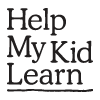Ages and stages
Children at this age talk about past, present and future events. In reading aloud they use different tones of voice to show meaning and feeling. They use longer and more complex sentences when they are speaking. They like to try out different words and concepts.
Ages 8 to 9
Children at this age talk about past, present and future events. In reading aloud they use different tones of voice to show meaning and feeling. They use longer and more complex sentences when they are speaking. They like to try out different words and concepts.
They use the concepts of time and distance. They tell more complicated stories and jokes, explain facts and give information.
During these years many children start to read comfortably. Others are still building words and sentences and prefer to read shorter pieces. Reading starts to become more important as part of their learning in school. Some children now love to write long pieces while others still find this quite difficult. All children need to be encouraged, to build confidence in their reading and writing.
If your 8 or 9 year-old child doesn’t understand something they can usually work out how to ask for more information, though it may take them a while to work out the right questions. Some children become very interested in facts and information around this age. They like to learn how to find out facts from books and the internet.
They are starting to use computers more and to develop their IT skills. They may need help to learn to control their computer use - to know when games are a good idea and when to stop playing; rules for using the internet and how to keep themselves safe.
Some children are starting to realise that different kinds of language suit different situations, that we speak differently when buying something in a shop, talking to friends or talking with an elderly neighbour.
At this age children develop their understanding of maths, such as realising that
3+4 is the same as 4+ 3. Your child may now readily use and understand the words ‘add’ and ‘take-away’. They are starting to understand how to multiply and divide. They are developing a good sense of money and the value of different coins and notes.
Activities at home are important to help their maths understanding. They are starting to work with fractions so activities to help them understand halves and quarters are especially helpful.
They notice more shapes in the world around. Sometimes they enjoy counting the sides in a shape and giving the right name, such as hexagon or octagon. They may like to draw different shapes and this will help their understanding and also their handwriting and co-ordination.
Some children now love to draw maps and many continue to create descriptive and imaginative drawings, often to communicate a story. They may use colour and paint to develop their communication further.
